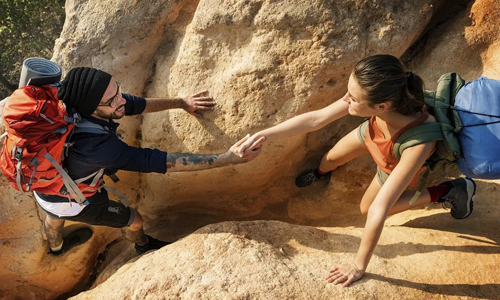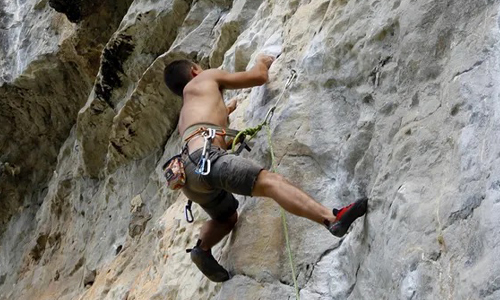Scramble Your Way to the Top With These Beginner’s Guide
Author

Author, writer, artist, photographer, analyst, dreamer, geek, gamer. As a freelance writer and blogger for Outdoor Look, Pete writes about the outdoors and why you should be in it. In the time that is left over from camping, running, hiking, cycling, writing novels and being a full time analyst, Pete sometimes mows the lawn, when he's ordered by Mrs Gillham!
If you are a fan of climbing mountains and rocky, hilly terrains, you must be aware of scrambling. For the uninitiated, scrambling is the activity where you have to use your hands to pull yourself up on the hilly vertical terrain. It gives you more support and stability.
Ideally for many people scrambling comes across as a dangerous and scary activity. The thought of a vertical terrain where normal trekking is difficult and where chances of a mishap increase are going to give chills to anyone. However, not all routes are like that. Some routes are less scary than imagined and some routes either require little scrambling or no scrambling at all.

You have to allow yourself to explore these routes by overcoming the fear associated with scrambling. And a good start to this journey would be to enhance your knowledge about various routes in the mountains and get on with the easy ones.
In the UK itself, there are so many hills and mountains that any mountaineer or explorer must have scrambled without even realising it. A route with prolonged scrambling sections involving tedious use of hands is established as a proper scrambling route.
Scrambling in the UK
The United Kingdom has a lot of mountains and hilly terrains. Thus, it gives you a variety of options. The mountains of the UK offer several hiking and scrambling routes. Guide books are available for all the main areas and are something you should read before starting your adventure.
The land also has some scrambling routes that are ideal for beginners. One of them is the Striding Edge in the Lake District, which has some beautiful breath-taking views.
Different Gradings for Scrambling
Scrambling routes in the UK are graded on three levels from 1 to 3, 1 being the easiest and 3 being the toughest.
Grade 1
Grade 1 scrambling is more like a challenging walk. It seldom happens that grade 1 scramble routes will feature prolonged steep and rocky sections. In this scrambling grade, you don’t require heavy technical skills and any hiker with little experience and some basic level of fitness can crack the hack.
Grade 2
Grade 2 scrambling is a confusing and tedium level. The distinction between scrambling and rock-climbing overlaps in this grade. At this level, the route is vertical and exposed and needs ropes for added safety in certain areas of the route.
Grade 3
Grade 3 scrambling is the most challenging one. These routes are often found in guide books where they guide you on how to traverse these routes. A good amount of knowledge and information about handling ropes is required at this level. Hence, only skilled, knowledgeable, and experienced mountaineers and hikers should be doing grade 3 scrambling.

Equipment for Scrambling
Beginner-level scrambling does not require any special tool or equipment besides the general hiking gear. However, with increasing levels of difficulty in grade two and three scrambling, one should have good quality sturdy ropes, helmets, and gloves with a good grip. It should be noted here that a pair of good-quality hiking boots with a reliable grip is a must for any hiking and scrambling activity.
Author

Author, writer, artist, photographer, analyst, dreamer, geek, gamer. As a freelance writer and blogger for Outdoor Look, Pete writes about the outdoors and why you should be in it. In the time that is left over from camping, running, hiking, cycling, writing novels and being a full time analyst, Pete sometimes mows the lawn, when he's ordered by Mrs Gillham!
Categories
- Sport (28)
- Product Reviews (3)
- Team Outdoor Look (7)
- Mike Wild (2)
- Mike Payton (2)
- Suse Hammond-Pears (3)
- Snowboarding (12)
- Latest Offers (105)
- Shop Talk (1)
- Competitions (7)
- Walking (413)
- Lifestyle Fashion (8)
- Travel (86)
- Kit Guides (176)
- Workwear Clothing (6)
- Safety Workwear (4)
- Health/Fitness (289)
- Skiing (91)
- Great Outdoors (1316)
- Cycling (92)
- January 2025
- December 2024
- November 2024
- October 2024
- September 2024
- August 2024
- July 2024
- June 2024
- May 2024
- April 2024
- March 2024
- February 2024
- January 2024
- December 2023
- November 2023
- October 2023
- September 2023
- August 2023
- July 2023
- June 2023
- May 2023
- April 2023
- March 2023
- February 2023
- January 2023
- December 2022
- November 2022
- October 2022
- September 2022
- August 2022
- July 2022
- June 2022
- May 2022
- April 2022
- March 2022
- February 2022
- January 2022
- December 2021
- November 2021
- October 2021
- September 2021
- August 2021
- July 2021
- June 2021
- May 2021
- April 2021
- March 2021
- February 2021
- January 2021
- December 2020
- November 2020
- October 2020
- September 2020
- August 2020
- July 2020
- June 2020
- May 2020
- April 2020
- March 2020
- February 2020
- January 2020
- December 2019
- November 2019
- October 2019
- September 2019
- August 2019
- July 2019
- June 2019
- May 2019
- April 2019
- March 2019
- February 2019
- January 2019
- December 2018
- November 2018
- October 2018
- September 2018
- August 2018
- July 2018
- June 2018
- May 2018
- April 2018
- March 2018
- February 2018
- January 2018
- December 2017
- November 2017
- October 2017
- September 2017
- August 2017
- July 2017
- June 2017
- May 2017
- April 2017
- March 2017
- February 2017
- January 2017
- December 2016
- November 2016
- October 2016
- September 2016
- August 2016
- July 2016
- June 2016
- May 2016
- April 2016
- March 2016
- February 2016
- January 2016
- December 2015
- November 2015
- October 2015
- September 2015
- August 2015
- July 2015
- June 2015
- May 2015
- April 2015
- March 2015
- February 2015
- January 2015
- December 2014
- November 2014
- October 2014
- September 2014
- August 2014
- July 2014
- June 2014
- May 2014
- April 2014
- March 2014
- February 2014
- January 2014
- December 2013
- November 2013
- October 2013
- September 2013
- August 2013
- July 2013
- June 2013
- May 2013
- April 2013
- March 2013
- February 2013
- January 2013
- December 2012
- November 2012
- October 2012
- September 2012
- August 2012
- July 2012
- June 2012
- May 2012
- April 2012
- March 2012
- February 2012
- January 2012
- December 2011
- November 2011
- October 2011
- September 2011
- August 2011
- May 2010
- April 2010
- March 2010
- February 2010
- January 2010
- November 2009
- October 2009
- September 2009


Submit a Comment